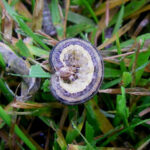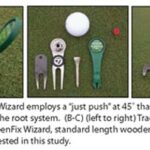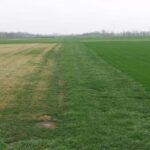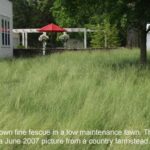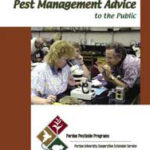Homeowner
MRTF Golf Day at The Fort in Indianapolis on September 29
Openings are still available for the MRTF Golf Day at The Fort Golf Resort in Indianapolis on September 29. This annual event is held to promote turfgrasss research, raise awareness of the Purdue Turfgrass Science Program, and provide an enjoyable day of golf. With a Centralized location and afternoon shotgun start we hope to draw […]
Fall Nitrogen Fertilization Benefits All Cool-Season Turfs
All cool-season turfgrasses benefit from fall nitrogen (N) fertilization, regardless if it is a lawn, athletic field, or golf course green, tee or fairway. Normally fertilization should begin in mid-September and continue one or two more times until about mid-November. Starting the fertilization program in September will take advantage of favorable growing weather and encourage […]
Armyworms Are Poised For Battle
We have been monitoring reports of very large infestations of armyworm moths flying into Kentucky this spring. Armyworms move north with storms from the southern states each year and depending upon how and where the storms blow will dictate when and how many moths we have to deal with. Fortunately, in Indiana we have not […]
Mowing height does not affect speed of athletes
We often hear the comment by coaches to change the mowing height of an athletic field when a particularly “fast” or “slow” team is coming to play. In a comprehensive article by Kevin Trotta in a June 16, 2004, “Turf News” article, he clearly showed that mowing height has little effect on player speed. Thought […]
Seeded bermudagrass or zoysiagrass is an option for some IN turf areas
In the southern third to of Indiana, seeded zoysia is a viable option for golf course fairway and tees, whereas seeded bermudagrass is an option for golf course fairways and athletic fields. A tremendous amount of recent research has been done on both of these species at Purdue as well as other universities. Our former […]
Ball mark Recovery: Does the Repair Tool Matter?
Putting green surface smoothness and uniformity is often disrupted by unrepaired ballmarks. These marks can disrupt surface smoothness and increase the potential for weed (e.g. annual bluegrass) encroachment. The traditional method for repairing ballmarks normally employs a metal pronged tool (≈ 1 in or 3 cm), or tee and using a knit and twist method […]
Color Variation in Residential and Commercial Lawns
During spring green-up, home lawns may reveal many variations in color, growth rate, and leaf width. This variation can be due to some of the following reasons: Species and cultivars: Perennial ryegrass is always the first of the desired cool-season grasses to green-up, followed by tall fescue and eventually Kentucky bluegrass. Within a species, different […]
Time is running out for spring seeding
As lawns are greening up, many calls are coming in about damage left over from last summer or perhaps even winter damage. Unfortunately, spring seeding is difficult at best because of pending hot weather and/or weed and disease pressure. Late summer (August) is easily the best time to seed cool-season grasses, but sometimes turf must […]
Reicher on Sabbatical until October 15
You’ll probably notice a slight decrease in frequency and number of Turf Tips this summer as I will be on sabbatical until Oct 15. I will be completing a national survey on Poa trivialis contamination in seed lots. This is a weed that we have been working on for years and it continues to plague golf courses, […]
Mole Control – Buyer Beware
Moles are back at it again!. These small subterranean, tunnel-making pests can cause big frustrations for those managing turfgrass and landscapes. Mole damage is most noticeable during the spring and fall, but spring may be the most effective time to control them. Moles are gray, furry, mammals that reach 6–8 inches in length. They have […]
Regenerating Fall Use Athletic Fields
With the fairly wet weather last fall, football and soccer fields have taken a beating. The fields that were aggressively aerified, fertilized, and dormant-seeded last fall should improve dramatically by mid-May. Though improvement won’t be as efficient done now compared to the fall, there is still time to help a field if you missed out […]
Searching for the no-mow” lawn grasses?
Most turfgrasses have leaves that only live for 30-60 days and thus constant growth is require to maintain ground cover, especially with any pets, children, or other traffic. The Holy Grail of “no-mow” turf is unlikely because the turf stand will thin allowing lots of weeds to encroach. That being said, any grass can be […]
Soil Tests
Soil test are important for determining P and K fertilization requirements. Though Purdue has been out of the soil testing business for many, many years, there is a list of certified soil testing labs at http://www.agry.purdue.edu/ext/soiltest.html. Taking an soil test is even more important than where it is sent for analysis. More information is available at http://www.agry.purdue.edu/turf/pubs/ay-18.pdf
Winter/spring flood damage on turf
After widespread flooding, many question how well turf will survive. Turf injury from flooding depends on water temperature, species, duration of submergence, and depth of submergence. Turfgrasses can withstand submersion for up to 60 days when water temperatures are 50 degrees or less. Injury is increased under stagnant water compared to moving water, and injury […]
Nitrogen and Phosphorus: fertilizing lawns to protect water quality
Healthy turf areas provide many environmental and recreational benefits. A properly fertilized turf has fewer weeds, is more resistant to insect feeding and is less disease prone than malnourished turf. Furthermore, a dense turf slow and decreases water runoff following storm events which helps reduce flooding in urban environments. Concern over water quality is growing […]
Do it yourself: Choose preemergence herbicides with as little N as possible: Part II
Per the earlier Turf Tip, select preemergence herbicides with as little nitrogen as possible to reduce the growth flush and maximize long-term health of the plant. The problem is finding a product with little or no N. Do not make the mistake of settling for a high N product and then reducing the application rate. […]
Do it yourself: Searching for that low maintenance lawn?
We get a ton of calls and email inquiring about low maintenance lawns. Simply put, there are no silver bullet grass species that are low maintenance and will also survive summers and winters in IN. That being said, hiring professionals to mow and maintain your lawn is the best method for reducing your input. Following […]
Choose Preemergence herbicides with as Little N as Possible
If a preemergence herbicide is justified on your lawn to control crabgrass now, most of those are available combined with fertilizer and you are forced to apply a fertilizer now. Look for a product with low nitrogen and be sure the majority of the nitrogen is a slow release N. Slow release sources include sulfur- […]
Offering Sound Pest Management Advice to the Public (PPP-62)
Purdue Extension Publication
This publication emphasizes the importance of providing sound pesticide advice to customers. Good diagnostic skills are essential. You personally must know and understand the behavior of various pests and have a working knowledge of various control options available; and must ensure that your customers understand your recommendations.
Purdue Alumni and Friends Reception at the GCSAA in Orlando
For those making the trip to Orlando for the GCSAA International Conference and Show, the Purdue Alumni and Friends Reception will be held Thursday, January 31 from 6:00 to 8:00 pm in Salon 4 of the Rosen Centre Hotel. It’s a great opportunity to catch up with your classmates and old friends. Please plan on […]
